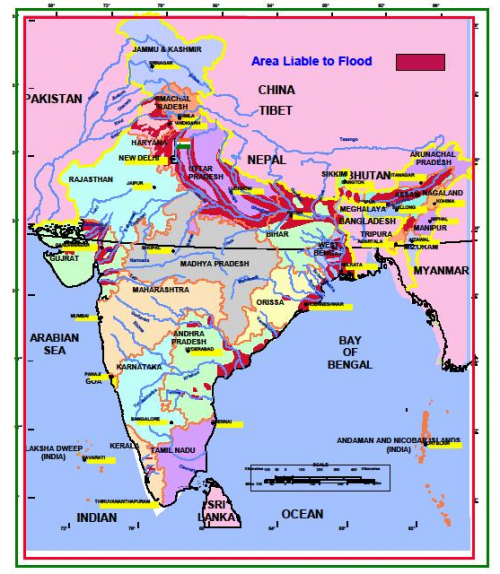Geography
India Needs an Updated Flood Map
- 14 Aug 2021
- 5 min read
Why in News
Recent occurrences of heavy rainfall leading to flooding across India have shown that flood-prone areas in the country go beyond those mentioned in the central monitoring map.
- The shift in the flooding patterns and frequencies demands an updated map of flood-prone areas, factoring in the impacts of climate change.
Flood Prone Areas According to NDMA
Key Points
- Flood Prone Areas in India:
- Regions susceptible to floods, according to the National Disaster Management Authority (NDMA), lie mostly along the Ganga-Brahmaputra river basin, from the northern states of Himachal Pradesh and Punjab, covering Uttar Pradesh and Bihar and stretching to Assam and Arunachal Pradesh in the northeast.
- The coastal states of Odisha and Andhra Pradesh, parts of Telangana and Gujarat also witness yearly floods.
- Need of a New Map:
- Old Estimation:
- The current demarcation is based on estimates made in 1980 by Rashtriya Barh Ayog (RBA) or National Flood Commission formed four decades ago.
- National Flood Commission, was set up by the Ministry of Agriculture and Irrigation in 1976, to study India’s flood-control measures after the projects launched under the National Flood Control Programme of 1954 failed to achieve much success.
- Around 40 million hectares of the geographical area in India is vulnerable to floods, according to the RBA.
- RBA also ascribed the floods to purely anthropogenic factors and not heavy downpours.
- The current demarcation is based on estimates made in 1980 by Rashtriya Barh Ayog (RBA) or National Flood Commission formed four decades ago.
- Climate Change:
- Over the last four decades, India has been reeling from the effects of climate change. The global rise in temperatures has led to large periods of no rain followed by extreme precipitation.
- Extreme rainfall events have tripled in central India between 1950 and 2015, according to the science journal Nature.
- There will be a rise in the frequency of floods in India due to rising temperatures between 2070 and 2100, according to Climate Change and India, a report by the Union Ministry of Environment and Forest.
- Increased Downpour:
- In recent times, the southwest monsoon period has also been causing massing floods in parts of the country in recent years.
- In 2020, 256 districts across 13 states in India reported floods due to excess rainfall.
- Old Estimation:
Flood
- It is an overflowing of water onto land that is normally dry. Floods can happen during heavy rains, when ocean waves come on shore, when snow melts quickly, or when dams or levees break.
- Damaging flooding may happen with only a few inches of water, or it may cover a house to the rooftop. Floods can occur within minutes or over a long period, and may last days, weeks, or longer. Floods are the most common and widespread of all weather-related natural disasters.
- Flash floods are the most dangerous kind of floods, because they combine the destructive power of a flood with incredible speed.
- Flash floods occur when heavy rainfall exceeds the ability of the ground to absorb it.
- They also occur when water fills normally dry creeks or streams or enough water accumulates for streams to overtop their banks, causing rapid rises of water in a short amount of time.
- They can happen within minutes of the causative rainfall, limiting the time available to warn and protect the public.
National Disaster Management Authority
- About:
- It.is the apex statutory body for disaster management in India. It was formally constituted in September 2006, in accordance with the Disaster Management Act, 2005 with the Prime Minister as its Chairperson and nine other members, and one such member to be designated as Vice-Chairperson.
- Mandate:
- To coordinate response to natural or man-made disasters and for capacity-building in disaster resiliency and crisis response.
- It is also the apex body to lay down policies, plans and guidelines for Disaster Management to ensure timely and effective response to disasters.
- Vision:
- To build a safer and disaster resilient India by a holistic, proactive, technology driven and sustainable development strategy that involves all stakeholders and fosters a culture of prevention, preparedness and mitigation.







